Da Mu
MTDA-HSED: Mutual-Assistance Tuning and Dual-Branch Aggregating for Heterogeneous Sound Event Detection
Sep 11, 2024
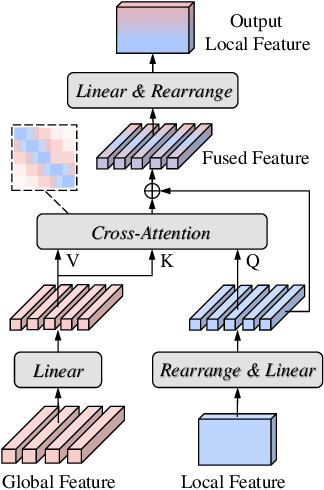
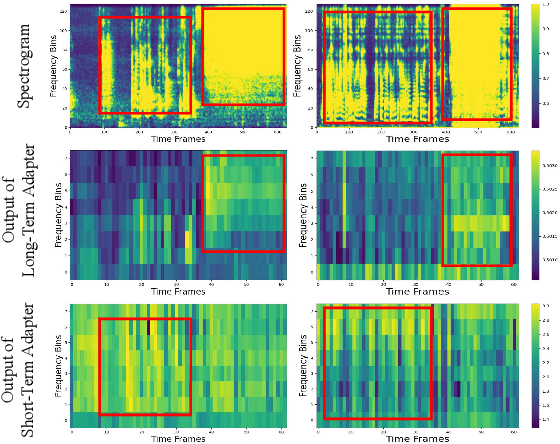
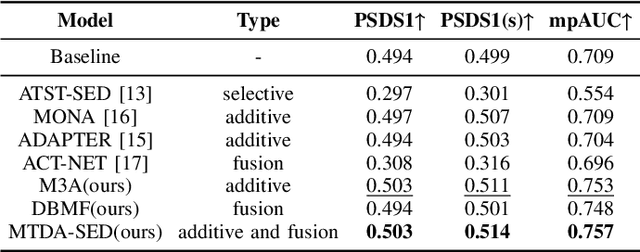
Abstract:Sound Event Detection (SED) plays a vital role in comprehending and perceiving acoustic scenes. Previous methods have demonstrated impressive capabilities. However, they are deficient in learning features of complex scenes from heterogeneous dataset. In this paper, we introduce a novel dual-branch architecture named Mutual-Assistance Tuning and Dual-Branch Aggregating for Heterogeneous Sound Event Detection (MTDA-HSED). The MTDA-HSED architecture employs the Mutual-Assistance Audio Adapter (M3A) to effectively tackle the multi-scenario problem and uses the Dual-Branch Mid-Fusion (DBMF) module to tackle the multi-granularity problem. Specifically, M3A is integrated into the BEATs block as an adapter to improve the BEATs' performance by fine-tuning it on the multi-scenario dataset. The DBMF module connects BEATs and CNN branches, which facilitates the deep fusion of information from the BEATs and the CNN branches. Experimental results show that the proposed methods exceed the baseline of mpAUC by \textbf{$5\%$} on the DESED and MAESTRO Real datasets. Code is available at https://github.com/Visitor-W/MTDA.
SELD-Mamba: Selective State-Space Model for Sound Event Localization and Detection with Source Distance Estimation
Aug 09, 2024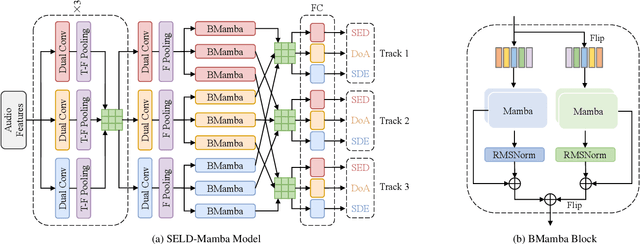

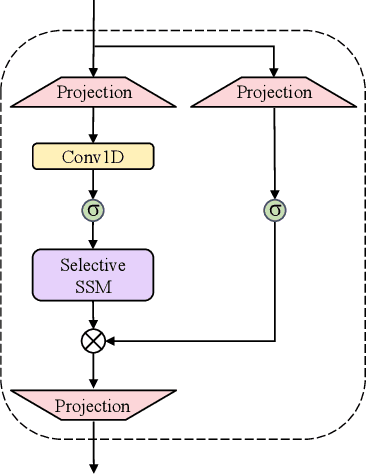

Abstract:In the Sound Event Localization and Detection (SELD) task, Transformer-based models have demonstrated impressive capabilities. However, the quadratic complexity of the Transformer's self-attention mechanism results in computational inefficiencies. In this paper, we propose a network architecture for SELD called SELD-Mamba, which utilizes Mamba, a selective state-space model. We adopt the Event-Independent Network V2 (EINV2) as the foundational framework and replace its Conformer blocks with bidirectional Mamba blocks to capture a broader range of contextual information while maintaining computational efficiency. Additionally, we implement a two-stage training method, with the first stage focusing on Sound Event Detection (SED) and Direction of Arrival (DoA) estimation losses, and the second stage reintroducing the Source Distance Estimation (SDE) loss. Our experimental results on the 2024 DCASE Challenge Task3 dataset demonstrate the effectiveness of the selective state-space model in SELD and highlight the benefits of the two-stage training approach in enhancing SELD performance.
MFF-EINV2: Multi-scale Feature Fusion across Spectral-Spatial-Temporal Domains for Sound Event Localization and Detection
Jun 15, 2024



Abstract:Sound Event Localization and Detection (SELD) involves detecting and localizing sound events using multichannel sound recordings. Previously proposed Event-Independent Network V2 (EINV2) has achieved outstanding performance on SELD. However, it still faces challenges in effectively extracting features across spectral, spatial, and temporal domains. This paper proposes a three-stage network structure named Multi-scale Feature Fusion (MFF) module to fully extract multi-scale features across spectral, spatial, and temporal domains. The MFF module utilizes parallel subnetworks architecture to generate multi-scale spectral and spatial features. The TF-Convolution Module is employed to provide multi-scale temporal features. We incorporated MFF into EINV2 and term the proposed method as MFF-EINV2. Experimental results in 2022 and 2023 DCASE challenge task3 datasets show the effectiveness of our MFF-EINV2, which achieves state-of-the-art (SOTA) performance compared to published methods.
Full-frequency dynamic convolution: a physical frequency-dependent convolution for sound event detection
Jan 10, 2024



Abstract:Recently, 2D convolution has been found unqualified in sound event detection (SED). It enforces translation equivariance on sound events along frequency axis, which is not a shift-invariant dimension. To address this issue, dynamic convolution is used to model the frequency dependency of sound events. In this paper, we proposed the first full-dynamic method named \emph{full-frequency dynamic convolution} (FFDConv). FFDConv generates frequency kernels for every frequency band, which is designed directly in the structure for frequency-dependent modeling. It physically furnished 2D convolution with the capability of frequency-dependent modeling. FFDConv outperforms not only the baseline by 6.6\% in DESED real validation dataset in terms of PSDS1, but outperforms the other full-dynamic methods. In addition, by visualizing features of sound events, we observed that FFDConv could effectively extract coherent features in specific frequency bands, consistent with the vocal continuity of sound events. This proves that FFDConv has great frequency-dependent perception ability.
 Add to Chrome
Add to Chrome Add to Firefox
Add to Firefox Add to Edge
Add to Edge